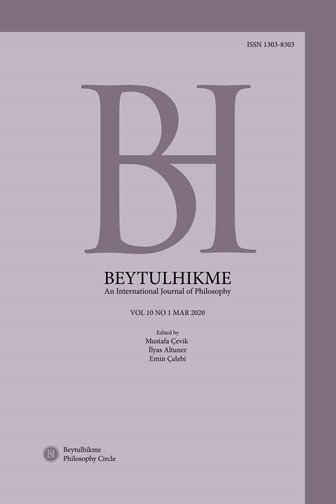Author :
Abstract
Platon'da cinslere ve türlere karşılık gelen kavramlar ve kavramlar arası ilişki formları içi boş kategoriler olmanın ötesinde varoluş dünyasına aşkın gerçekliklere işaret eder. Cins ve tür ilişkisi problemi deyince akla gelen ilk kişi Aristoteles'tir. Ancak Platon ve Aristoteles bu konuda karşıt düşüncelere sahiptir. Aristoteles cinslere ve türlere karşılık gelen genel kavramları zihnin içi en boş soyutlamaları olarak kabul ederken hocası Platon bunların en saf gerçeklere karşılık geldiğini düşünür. Bu anlayışı doğrultusunda Platon olumlu ve olumsuz önermelerdeki kavramlar arası ilişkilerin doğruluk ve yanlışlığını somut gerçeklik ilişkilerinden hareketle ele almaz, aksine saf gerçekler olarak kabul ettiği formlar arası ilişkilerden yola çıkarak ele alır. Platon'da olumsuz önermeler ve hiçlik problemini ele alacağımız makalemizde, problemin sarih bir açıklaması için Platon'da cins/tür anlamındaki "Form" kavramının gelişimi, formların aşkınlığına alan açmak için Protagoras'ın algı kuramına getirilen eleştiriler, formlar arası "pay alma" kuramı ve bütün bu problemleri düşünme yöntemi olan diyalektikten ne anladığı açıklanarak makalenin temel problemini oluşturan summa generia dediği salt formlar arası ilişkilerden doğan olumlu-olumsuz önermeler bağlamında Platon'un Varlık ve Hiçlik'e getirdiği açıklamalar ele alınacaktır.
Keywords
Abstract
In Plato, the concepts and the forms of relationship between the concepts that correspond to genera and species imply realities that transcend the world of existence, rather than hollow categories. Aristotle is the first person that comes to mind when it comes to the problem of genus-species relations. However, Plato and Aristotle have opposing views. While Aristotle considers the general concepts corresponding to genera and species to be the hollow abstractions of the mind, Plato thinks that these correspond to the purest realities. In line with this understanding, Plato does not deal with the truth and inaccuracy of inter-conceptual relations within the positive and negative propositions drawing from concrete reality relations but rather based on relations among the forms themselves, which he accepts as pure realities. In our article in which we will discuss the negative propositions and the problem of nothingness in Plato, for sake of a clear explanation of the problem, we will explain the development of Plato's concept of "Form" in the sense of genus/species, his criticism directed towards Protagoras' theory of perception to open a space for the transcendence of the forms, his theory of "partaking" among the forms, and what he understands with the dialectics which is the method of thinking all these problems; in this way, we will discuss –as the main problem of the article- the explanations on the concepts of Being and Nothingness made by him within the context of positive-negative propositions which arise from the relations among the absolute forms, or -using the terms of Plato- "summa genera".
Keywords
- Ashbaugh, A. F. (1988). Plato's Theory of Explanation: A Study of Cosmological Account in the Timaeus. Albany: State University of New York Press.
- Bigger, C. P. (1968). A Platonic Inquiry. Charlotte: Louisiana State University Press.
- Brumbaugh, R. S. (1961). Plato on the One: The Hypotheses in the Parmenides. New Haven: Yale University Press.
- Clearly, J. J. (1997). The Perennial Tradition of Neoplatonism. Leuven: Leuven Uni- versity Press.
- Cornford, F. M. (1989). Platon'un Bilgi Kuramı. (Çev. A. Cevizci). Ankara: Gündo- ğan Yayınları.
- Dillon, J. (1993). The Handbook of Platonism. Oxford: Clarendon Press.
- Helmig, C. (2012). Forms and Concepts: Concept Formation in the Platonic Tradi- tion.Berlin & Boston: Walter de Gruyter.
- Mattei, J. F. (2008). Platon. (Çev. İ. Yerguz). Ankara: Dost Kitabevi.
- Peters, F. E. (2004). Antik Yunan Felsefesi Terimleri Sözlüğü. (Çev. H. Hünler) İs- tanbul: Paradigma Yayıncılık.
- Platon (1992). Devlet. (Çev. S. Eyüboğlu & M.A. Cimcoz). İstanbul: Remzi Kita- bevi.
- Platon (1996). Parmenides. (Çev. S. Babür). Ankara: İmge Kitabevi.
- Platon (1997a). Timaios. (Çev. E. Güney & L. Ay). İstanbul: Millî Eğitim Bakanlığı Yayınları.
- Platon (1997b). Theaitetos. (Çev. M. Gökberk). İstanbul: Millî Eğitim Bakanlığı
- Platon (2000). Sofist. (Çev. C. Karakaya). İstanbul: Sosyal Yayınlar.
- Platon (2001). Epinomis. (Çev. A. Cemgil). İstanbul: Sosyal Yayınlar.
- Platon (2013). Phaidon. (Çev. F. Akderin). İstanbul: Say Yayınları.
- Reale, R. (1997). Toward a New Interpretation of Plato. (Trans. J. R. Catan & R. Davies). Washington: The Catholic University of America Press.
- Ross, S. D. (1951). Plato's Theory of Ideas. London: Oxford University Press.
- Rickless, S. C. (2006). Plato's Forms in Transition: A Reading of the Parmenides. San Diego: University of California Press.





